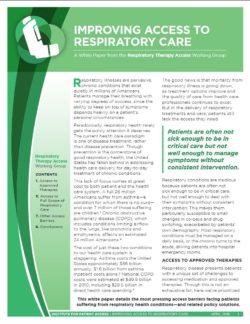Improving Access to Respiratory Care
August 6, 2017
 Respiratory illnesses are pervasive, chronic conditions that exist quietly in millions of Americans. Patients manage their breathing with varying degrees of success, since the ability to keep on top of symptoms depends heavily on a patient’s personal circumstances.
Respiratory illnesses are pervasive, chronic conditions that exist quietly in millions of Americans. Patients manage their breathing with varying degrees of success, since the ability to keep on top of symptoms depends heavily on a patient’s personal circumstances.
Paradoxically, respiratory health rarely gets the policy attention it deserves. The current health care paradigm is one of disease treatment, rather than disease prevention. Though prevention is the cornerstone of good respiratory health, the United States has fallen behind in addressing health care delivery for day-to-day treatment of chronic conditions.
This lack of focus comes at great cost to both patient and the health care system. A full 26 million Americans suffer from asthma—a condition for which there is no cure— and over 7 million of those suffering are children. Chronic obstructive pulmonary disease (COPD), which includes conditions limiting airflow to the lungs, like bronchitis and emphysema, affects an estimated 24 million Americans.
The cost of just these two conditions to our health care system is staggering. Asthma costs the United States approximately $56 billion annually; $1.6 billion from asthma inpatient costs alone. National COPD costs were estimated at $49.9 billion in 2010, including $29.5 billion in direct health care spending.
The good news is that mortality from respiratory illness is going down, as treatment options improve and the quality of care from health care professionals continues to excel. But in the delivery of respiratory treatments and care, patients still lack the access they need.
Respiratory conditions are insidious because patients are often not sick enough to be in critical care, but not well enough to deal with their symptoms without consistent intervention. This makes them particularly susceptible to small changes in co-pays and drug switching, exacerbated by patients’ own demography. Most respiratory conditions must be managed on a daily basis, or the chronic turns to the acute, driving patients into hospital emergency rooms.
Tags: Cost Sharing, Prior Authorization, Respiratory
Categorized in: Policy Papers, White Papers

